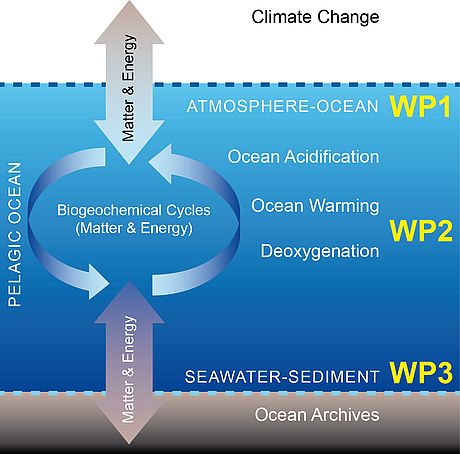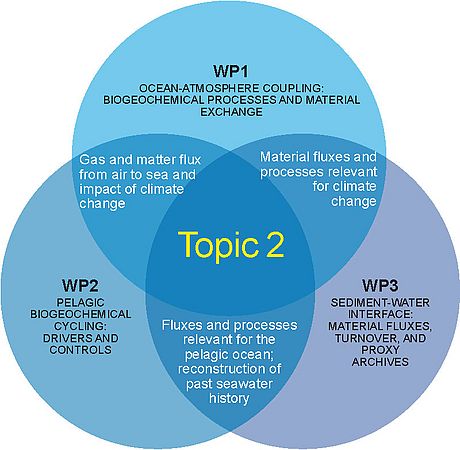Topic 2: Ocean Warming, Acidification and Deoxygenation
Topic speaker: Prof. Dr. Klaus Wallmann
(Deputy: Prof. Dr. Anja Engel)
Mission:
Topic 2 investigates biogeochemical cycles and processes at the air-seawater and the seawater-sediment interfaces and the pelagic ocean between them. The investigations aim to understand and quantify the transformations and fluxes at the interfaces and throughout the water column on all time scales with special focus on the impacts of global change and feedbacks to the climate system.
Challenges
Natural and anthropogenic alterations of marine biogeochemical cycles provide both opportunities and risks to the human society. In this regard research performed in Topic 2 aims to improve our understanding of these changes and their possible consequences, thereby contributing to the Grand Challenge “Earth system dynamics and risks” of the Helmholtz Society. Research on marine biogeochemical interactions with the regional and global climate on all time scales contributes to the challenge “Climate variability and climate change.” The Grand Challenge “Ecosystem dynamics and biodiversity” is addressed in Topic 2 through studies combining ecological and biogeochemical approaches ranging from the cellular to the ecosystem level. We address the Grand Challenge “Socio-political dimensions of global change” through the development and application of numerical models to improving our understanding of global biogeochemical cycles, providing relevant aspects to policy and decision makers.

Current Activities and Previous Work
Topic 2 scientists use a variety of experimental and observational approaches, state-of-the-art analytical techniques and computer modelling to investigate the marine biogeochemical cycles and the exchange of matter across the two major oceanic interfaces. A particular strength of Topic 2 is the interdisciplinary interaction of oceanographers, chemists, biologists, geologists and modellers, combining in-situ field technology, laboratory studies, numerical transport-reaction modelling and proxy archive reconstructions of the past ocean. Following this approach, Topic 2 scientists are able to predict and reconstruct responses of biogeochemical cycling to past and present environmental changes. The respective processes are investigated at all scales and depths of the world’s oceans.
At the top of the water column, the interface between the oceans and atmosphere covers ~71 % of the Earth’s surface. Exchanges of matter (e.g., greenhouse gases) across this interface constitute important drivers of Earth’s climate on a variety of timescales ranging from sub-daily to Phanerozoic (i.e., glacial-interglacial cycles) timescales. Marine biogeochemical processes both drive and are driven by air-sea interaction and therefore mediate the major source or sink functions of the ocean for a variety of radiatively and chemically active atmospheric trace gases. Accumulation of organic and inorganic substances, together with intense biological activity, at the ocean-atmosphere interface leads to unique and heterogeneous physicochemical and biological properties, deviating greatly from bulk seawater conditions. Scientists in Topic 2 decipher the processes that determine matter exchange across the oceans outer skin, which is crucial for understanding ocean-atmosphere interaction and making reliable projections of responses to global change.
The water column between the sea surface and the ocean floor hosts the largest ecosystem on Earth. The planktonic organisms inhabiting this ecosystem are responsible for about half of the global primary production and form the base of the marine food web. These organisms are the main drivers of elemental cycling, of greenhouse gas exchange between the oceans and atmosphere, including the sequestration of atmospheric CO2 in the deep ocean, and for supplying organic matter to the sediments. Through these processes the pelagic ecosystem generates important feedbacks in the climate system [link to Topic 1]. In turn, changes in environmental conditions due to natural and anthropogenic perturbations modulate pelagic ecosystems and biogeochemistry, with presently unknown consequences for marine ecosystems, productivity and global climate. To better understand and predict these consequences, Topic 2 scientists apply molecular, physiological, ecological and biogeochemical approaches through lab- and field-based perturbation experiments, field observations and ecosystem and biogeochemical modelling [link to Topic 3].
The interaction of the deep marine sediments (benthos) with the water column above (pelagial) plays a fundamental role in marine biogeochemistry, since the oceans´ nutrient and carbon inventories are regulated by material fluxes across the sediment-seawater interface. The processes occurring at the benthic-pelagic interface are studied in an interdisciplinary approach using a variety of highly sophisticated sea-going instruments (e.g. landers), in-situ field and laboratory experiments, as well as theoretical modelling. Scientific activities related to the sediment-seawater interface focus on its role as a source for gaseous, mineral and silicate resources and on its role as a material sink, including anthropogenic CO2. Microbial life is of particular interest, because it can significantly modify chemical processes and material fluxes at the sediment-seawater interface. Topic 2 scientists also make use of seafloor archives to reconstruct the chemical history of seawater and the processes occurring within the oceans using sophisticated isotopic proxies and related methods. Topic 2 members are also involved in ongoing basic science and applied projects, addressing the formation and stability of submarine gas hydrates.
Current research activities are integrated into major national and international research projects including the BMBF projects BIOACID, SOPRAN and ICOS-D, the bi-national (American-German) project Acidification Effects on Aggregation in the Ocean (ADAGIO), collaborations with AWI (PEBCAO), and the EU projects EPOCA, SHIVA, InGOS, CARBOCHANGE, HYPOX, and OSS2015. Members of Topic 2 coordinate BIOACID and SHIVA. Scientists of this topic are heavily involved in the SFB 754 and the Excellence Cluster Future Ocean (see 2.1.2). Assessing potential effects of global warming on the stability of submarine gas hydrates and correlated benthic processes are part of the research activity within the Cluster and as part of the EU-COST Action PERGAMON programme. In the projects CALMARO (EU), BIOACID (BMBF) and TRION (DFG), trace element and isotope geochemistry is being investigated during marine biomineralisation in order to gain new insights into ocean acidification. Within the project PHARAO (DFG), the alkaline earth isotope systems (δ44/40Ca, δ26/24Mg, δ88/86Sr) are being used to reconstruct the Phanerozoic history of ocean warming, deoxygenation and acidificaction. Deoxygenation, fluid seepage processes, benthic hydrocarbon turnover, and formation of authigenic carbonates are studied in projects such as the Southern German North Sea Project (Wintershall), the Jeddah Transect Project (GTZ), and the SPP1319 “Biological transformation of hydrocarbons without oxygen: from the molecular to the global scale” (DFG).
Objectives
Marine biogeochemical processes and cycles are different depending on the depth of their height in the water column and the local physico-chemical settings. The topic includes three work packages, which cover the air-sea interface (WP1), the pelagic water column (WP2) and the seawater-sediment interface (WP3). The WPs in Topic 2 are linked to each other at the interfaces and via the process of understanding and modelling integrating biogeochemical cycling across all interfaces and beyond.
Work package 1 “Ocean-atmosphere coupling: biogeochemical processes and material exchange” studies the biogeochemical processes including trace gas exchange, trace element cycling and dust input at the physically and chemically active air-seawater interface, which also borders the surface ocean supporting most marine life.
Work package 2 “Pelagic biogeochemical cycling: drivers and controls” studies the pelagic ocean, which encompasses the water column from the air-seawater to the sediment-seawater interface hosting the largest ecosystem on Earth. Reliable predictions on material fluxes for the pelagic ecosystems in response to global change require a mechanistic understanding of the complex biological responses to a rapidly changing marine environment.
Work package 3 “Sediment-water interface: material fluxes, turnover, and proxy archives” studies the biogeochemical processes at the seawater-sediment interface, where a variety of materials are transferred from the seafloor into the oceans, including nutrients, dissolved organic and inorganic carbon, methane, major cations and anions and various trace elements. In addition, the seafloor also provides geochemical archives providing proxy information about past biogeochemical cycles and processes.



